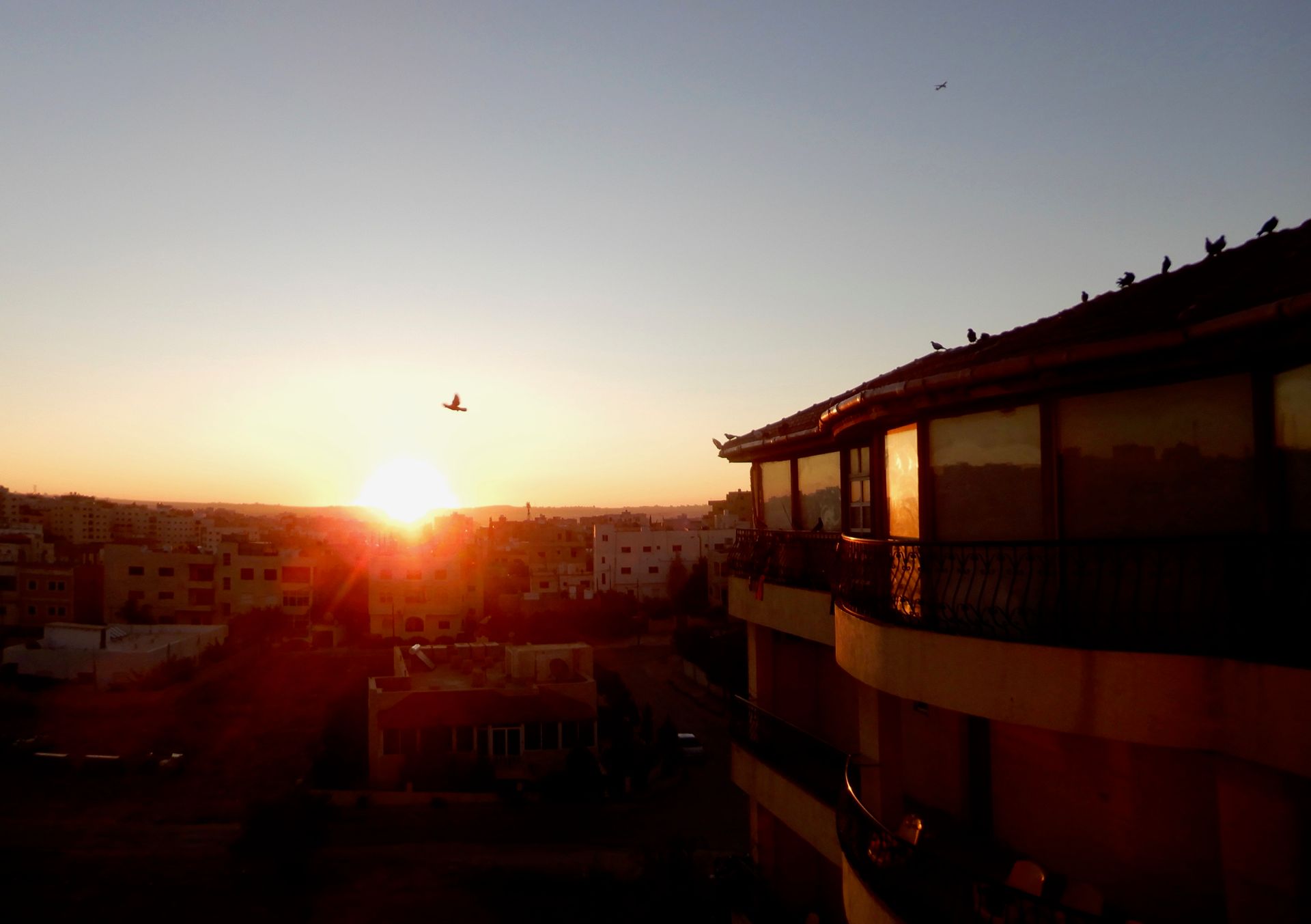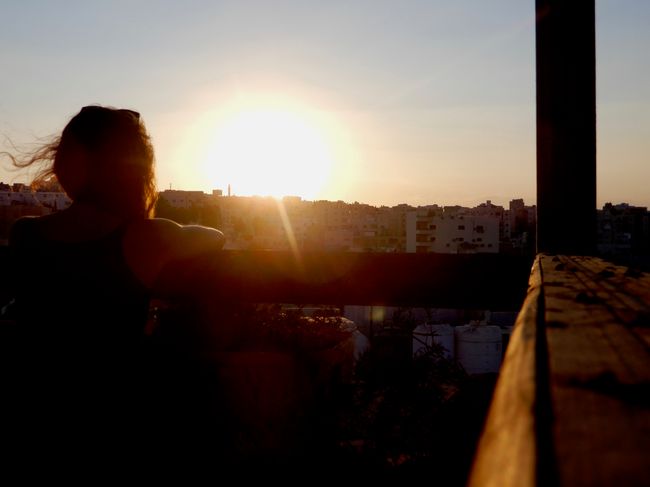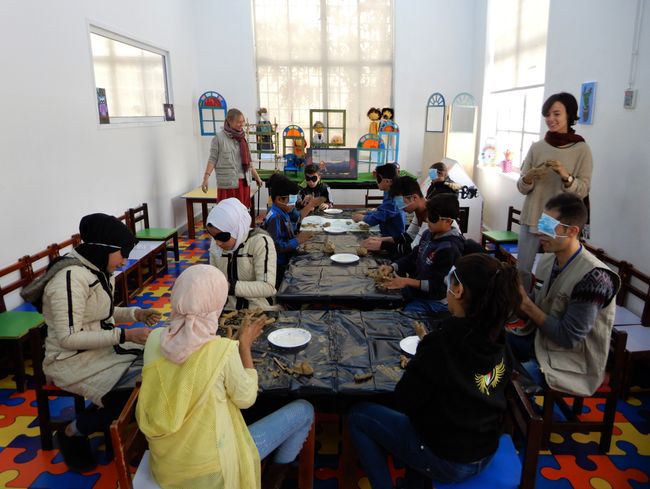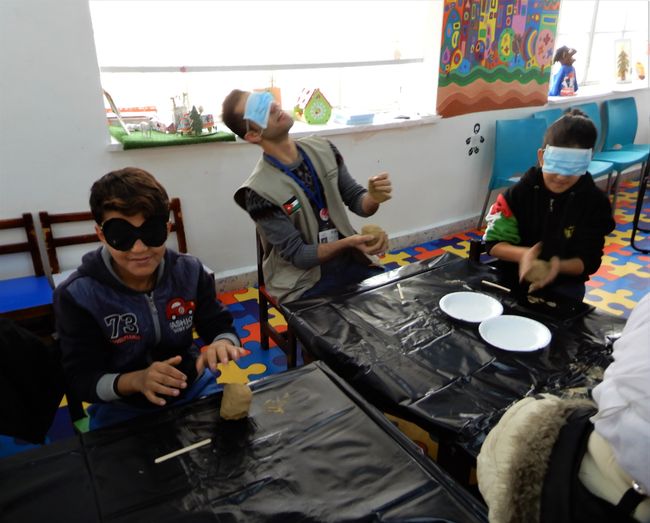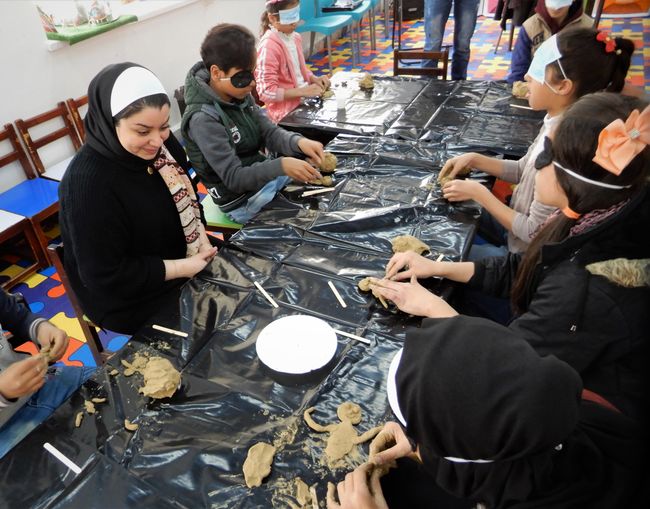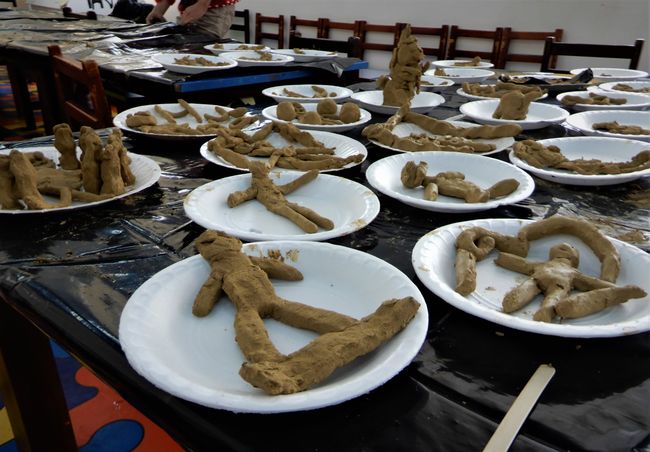Mindful Clay Workshop
ପ୍ରକାଶିତ |: 26.11.2019
ସମ୍ବାଦପତ୍ରକୁ ସବସ୍କ୍ରାଇବ କରନ୍ତୁ |
Monday, November 25th
7:50 am. I repeat myself. It's always the most important days that I oversleep. Rudaina and Clara are already waiting for me at the First Circle while I'm just waking up from deep sleep. I send them off ahead, quickly swallow a few bread crumbs with hummus, wash my face, and then take an uber to Tarabot. Luckily, I don't get caught in the rush hour traffic and arrive 20 minutes before the workshop starts. Close call.
The girls have prepared everything when I enter the room where our workshop takes place. Another room where we originally planned to have it - unexpectedly, there are several other activities happening at Tarabot today. But we've already practiced flexibility in the past weeks. At exactly 9 am, it begins: 20 children walk in and shyly but curiously sit down on the huge row of sofas, where their presence is initially checked. They look younger than expected - 13-16-year-olds were our preferred target group. Fuad will later tell us that the children here are between 12 and 15 years old, but they feel more like 12 than 15. But as I said, we are flexible.
The children are now divided into two groups. We will conduct the workshop twice in the next two hours, with each half of the group, while the other half will do a storytelling workshop with Kemo. Rudaina now welcomes the first group, and without understanding in detail what she is saying, I can tell that she has a good connection with the children. We start with a small welcoming game, in which the children state their names and something they like to do or have, then the first game related to our theme: 'Discover your boundaries'. It is about using your arms and legs to encircle an imaginary ball around yourself to find out where your own boundaries begin and end. While one child explores their boundaries with their arm spans, the other children enter their personal safe zone. This way, the children should get a sense of how much space they need for themselves. In the first group, all the younger children participate surprisingly well, and they have fun testing their own limits.
After Rudaina reflects on this activity with the children in Arabic, the next part follows: a short meditation. Again, with the aim of getting a better sense of their own bodies. While Rudaina guides them on which body part to concentrate on, I would have expected more commotion in this age group. However, everything is very calm, although it can be seen that some children participate in the meditation with more concentration than others. Then, the main part of our workshop: blind pottery. We have distributed blindfolds to all the seats, and after a few initial difficulties (some of the blindfolds don't fit well over the girls' hijabs), we start. We have already noticed while distributing the clay that it is quite wet, and the mess that is about to happen awaits us. The mushy clay spreads quickly on the tables (which we fortunately prepared with foil beforehand), jackets, sweaters, hair, and blindfolds. But it works: step by step, the shapeless clay lumps turn into larger and smaller bodies.
One detail in contrast to the figures we created ourselves three weeks ago at Al-Iraq al Amir holds special significance: the face. Almost all the figures have clearly visible eyes and a smiling mouth. In some sculptures, it can also be seen that the boundary activity has left its mark: some children outline their figure with a frame or a house-like structure.
Dr. Amina comes in and sits with the children for a while. She is a trained psychologist and later tells us what her trained eyes have observed: a boy who sat in the back corner has formed a very tiny figure. So small that you can hardly recognize that it is a body. Amina tells us that he squeezed his eyes tightly shut while shaping, unlike all the other children who occasionally peeked under their masks to see what their hands had already created. Amina tells us that this micro figure is an indication that this boy is currently burdened with something very heavy. He also repeatedly reshaped the eyes of his figure. Even when everyone removed their blindfolds and it was clearly visible that the legs of his tiny figure were uneven in length, he only focused on the eyes of the figure and continued to work on them. As Amina tells us this, I realize that amidst all the happiness and joyfulness of the children towards us at Tarabot, I have somewhat forgotten about the baggage that many of these predominantly Syrian children carry with them on a daily basis.
When the first group finishes and leaves the room, we are eager to clean up the biggest mess as quickly as possible, while Rudaina is already outside in the large hall conducting the boundary game with the second group. She will later tell us that it was a bit more exhausting with this second group. It is now full house at Tarabot: another NGO is using the premises for another event, which is why the large hall is full of unfamiliar people, and Rudaina and the kids feel somewhat observed and uncomfortable during the game. Additionally, the older children are in the second group, and they initially make a calmer impression on me during pottery. Rudaina understands everything that is being said and tells us that the teenage girls made fun of her instead of taking the workshop seriously. Interestingly, it was the opposite with the boys of the same age - they were much more focused.
Nevertheless, the individual personality boundaries that Rudaina discussed with the kids beforehand are also reflected in the figures of the second group - again, many boundary-like structures can be seen around the figures. It is also noticeable that some children create more than one figure: other people or even pets can be seen. I become aware that the children's environment plays a big role in their lives. "No man is an island," as I have learned so often in my studies. This workshop has incredible potential and could be built into something much bigger with more time. Dr. Amina agrees and considers conducting the activity next week with a group of women at Tarabot.
We, the chaos group, are now just glad that our workshop went more or less smoothly. Glad and relieved. Now we deserve a lunch break, and Sophia and I are proud to lead Rudaina and Clara to Abu Wahid, who greets us with joy as always. However, today the other customers behave somewhat differently. Rudaina immediately tells us why: because of her. This is not a place where Jordanian women usually go, she says, so her presence here is somewhat unsettling for everyone present. A group of men poke their heads in and retreat when they see our group of four sitting inside. Something happens that has never happened before since Sophia and I started eating here: the men carry a table outside and eat by the roadside. "It's so weird to be here," Rudaina comments. However, her discomfort eases when the food arrives, and we all float on cloud nine of taste. "I think, I'll come back!", Rudaina updated her opinion.
Afterwards, Rudaina and Clara head back to the city, while Sophia and I sit in our English classroom and prepare the lesson for next Wednesday. It takes a bit longer than expected, and we are surprised when we return to the room where our workshop took place this morning and find no more clay figures (the children didn't want to take their figures with them - it's peer pressure, as Rudaina tells us). Our Tarabot colleagues thought we had already left for the day and disposed of the figures. We had actually planned to keep some of the figures for our final presentation at the university. Fortunately, we took pictures of everything. After all, we are flexible. Very flexible.
ସମ୍ବାଦପତ୍ରକୁ ସବସ୍କ୍ରାଇବ କରନ୍ତୁ |
ଉତ୍ତର
